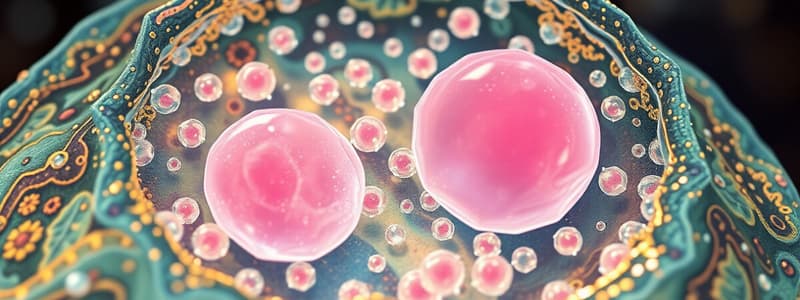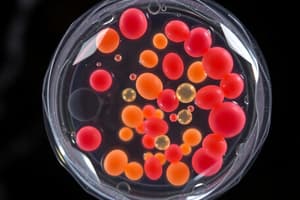Podcast
Questions and Answers
Which characteristic distinguishes living cytoplasmic organelles from cytoplasmic inclusions?
Which characteristic distinguishes living cytoplasmic organelles from cytoplasmic inclusions?
- Living organelles are metabolically inert.
- Living organelles are transient.
- Living organelles are vital for the cell. (correct)
- Living organelles are non-living structures.
What structure is considered the outermost covering of the cell?
What structure is considered the outermost covering of the cell?
- Organelles
- Nucleus
- Cytoplasm
- Cell membrane (correct)
Which of the following is NOT an example of a membranous organelle?
Which of the following is NOT an example of a membranous organelle?
- Ribosomes (correct)
- Golgi apparatus
- Endoplasmic reticulum
- Mitochondria
What is true about cytoplasmic inclusions?
What is true about cytoplasmic inclusions?
Which of the following organelles contains enzymes?
Which of the following organelles contains enzymes?
Which cytoplasmic organelle is known for its role in secretion and processing of proteins?
Which cytoplasmic organelle is known for its role in secretion and processing of proteins?
How does the shape of a cell vary?
How does the shape of a cell vary?
Which of the following characteristics applies to non-membranous organelles?
Which of the following characteristics applies to non-membranous organelles?
Which of the following types of organelles is NOT considered metabolically active?
Which of the following types of organelles is NOT considered metabolically active?
What role does the cell membrane play in the cell?
What role does the cell membrane play in the cell?
What is the primary function of cholesterol in the cell membrane?
What is the primary function of cholesterol in the cell membrane?
Which component of the cell membrane is exclusively found on its outer surface?
Which component of the cell membrane is exclusively found on its outer surface?
How do integral proteins interact with the phospholipid bilayer?
How do integral proteins interact with the phospholipid bilayer?
Which method of transport requires carrier proteins to assist movement?
Which method of transport requires carrier proteins to assist movement?
What is the role of the glycocalyx?
What is the role of the glycocalyx?
What distinguishes active transport from passive diffusion?
What distinguishes active transport from passive diffusion?
Which of the following correctly describes glycoproteins?
Which of the following correctly describes glycoproteins?
What type of transport involves the uptake or release of large molecules through vesicles?
What type of transport involves the uptake or release of large molecules through vesicles?
Which membrane proteins are typically smaller and located on both surfaces of the membrane?
Which membrane proteins are typically smaller and located on both surfaces of the membrane?
How are phospholipid molecules in the cell membrane arranged?
How are phospholipid molecules in the cell membrane arranged?
What distinguishes phagocytosis from pinocytosis?
What distinguishes phagocytosis from pinocytosis?
What is the primary role of receptor-mediated endocytosis?
What is the primary role of receptor-mediated endocytosis?
What is the fate of a vesicle formed during endocytosis?
What is the fate of a vesicle formed during endocytosis?
Which statement about exocytosis is correct?
Which statement about exocytosis is correct?
What is a key function of cell coat as described in the content?
What is a key function of cell coat as described in the content?
Which process requires the active transport of substances out of the cell?
Which process requires the active transport of substances out of the cell?
What is the relationship between lysosomes and endocytosis?
What is the relationship between lysosomes and endocytosis?
What role does the cell coat have concerning pathogens?
What role does the cell coat have concerning pathogens?
What substance is primarily secreted through exocytosis?
What substance is primarily secreted through exocytosis?
Which of the following best describes pinocytosis?
Which of the following best describes pinocytosis?
Flashcards are hidden until you start studying
Study Notes
Structure of the Cell
- Cells are the fundamental structural and functional units of living organisms.
- Size ranges from 4 to 150 micrometers.
- Shapes include rounded, oval, flat, cubical, columnar, and polygonal.
- Functions encompass secretion, absorption, sensation, and contraction.
Cell Components
- Composed of cytoplasm, nucleus, organelles, and inclusions.
Cytoplasmic Organelles vs. Inclusions
- Cytoplasmic Organelles:
- Living, permanent structures vital for metabolic functions.
- Examples include mitochondria, endoplasmic reticulum, and Golgi apparatus.
- Cytoplasmic Inclusions:
- Non-living, transient structures not essential for cell viability.
- Metabolically inert with examples including lipids and pigments.
Types of Cytoplasmic Organelles
-
Membranous Organelles: Surrounded by membranes, contain enzymes.
- Include cell membrane, mitochondria, endoplasmic reticulum, Golgi apparatus, lysosomes, and peroxisomes.
-
Non-Membranous Organelles: Not surrounded by membranes, generally lack enzymes.
- Examples are ribosomes, cytoskeleton (comprising filaments and microtubules), and proteasomes.
Cell Membrane
- Acts as the outer boundary of the cell, separating cytoplasm from extracellular fluid.
- Structure visible under an electron microscope as a trilamellar membrane.
- Consists of a phospholipid bilayer interspersed with cholesterol, integral proteins, and peripheral proteins.
Molecular Structure of Cell Membrane
-
Lipid Component:
- Phospholipids arranged in two layers with hydrophilic heads outward and hydrophobic tails inward.
-
Protein Component:
- Peripheral proteins are small and located on either surface.
- Integral proteins span the bilayer, embedding within the phospholipid layers.
-
Carbohydrate Component:
- Found only on the outer surface; includes glycoproteins (sugar chains linked to proteins) and glycolipids (sugar chains linked to phospholipids).
Glycocalyx (Cell Coat)
- Composed of glycoproteins and glycolipids on the outer membrane.
- Appears fuzzy under an electron microscope.
- Functions include protection, identity recognition, and interaction with other cells.
Functions of Cell Membrane
- Transport of Materials:
- Passive diffusion allows unassisted movement down a concentration gradient.
- Facilitated diffusion relies on carrier proteins for transporting ions and small molecules.
- Active transport moves substances against their concentration gradient (e.g., Na/K pump).
- Bulk transport (vesicular transport) includes endocytosis and exocytosis.
Endocytosis
- Process by which the cell engulfs extracellular substances via a membrane vesicle.
- The vesicle can fuse with lysosomes for digestion.
- Types include:
- Phagocytosis: Engulfment of solid particles.
- Pinocytosis: Engulfment of fluid droplets.
- Receptor-mediated Endocytosis: Selective uptake of substances via specific receptor proteins.
Exocytosis
- Mechanism for expelling substances from the cell, crucial for secretion of hormones and mucus.
- Involves vesicles that migrate to the cell membrane and release contents upon fusion.
Functions of Cell Coat
- Provides protection and stabilization.
- Aids in cell identity and recognition.
- Facilitates cell-cell interactions and acts as receptors for pathogens.
Studying That Suits You
Use AI to generate personalized quizzes and flashcards to suit your learning preferences.




